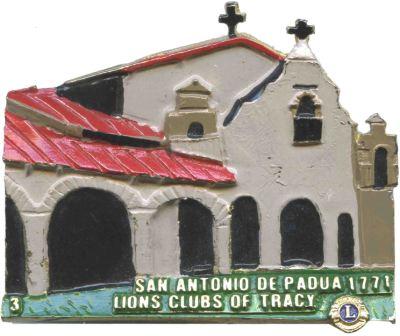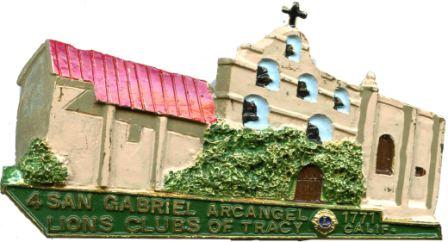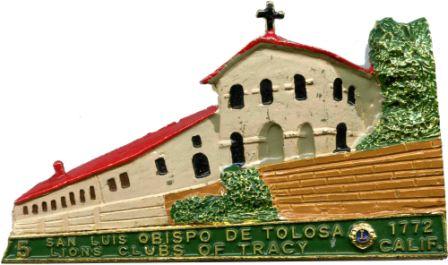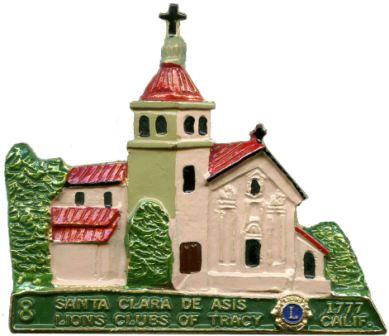 California Mission Story
California Mission Story
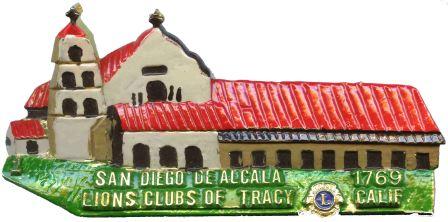
The Brief History of the California Missions
Lion Richard Hall, California
(Note: Clicking on the name of the mission will display a larger image of the pin.)
The California Missions were built and operated by the Franciscan Missionaries, beginning in 1769 with Mission San Diego de Acala and ending with Mission San Juan de Solano (now known as the Sonoma Mission, located just north of San Francisco Bay) They were built in no particular geographical order but in those places where there was the largest congregation of Indians, as well as the greatest amount of fertile land. When completed, there was a string of missions beginning in San Diego, and ending in Sonoma. They were spaced between 30 to 50 miles apart, about as far as a person on horseback or wagon could travel in one day. The missions were connected by a single wagon trail and given the very auspicious name of El Camino Real, or The Kings Highway. In modern times, this is the basic route of U.S. Highway 101. As the years passed, the missions were more than training grounds for the Indians. Everyone was welcome and could always count on a place to stay overnight and have a good meal.
The California Indians serviced by the missions represented only a small fraction of the Indians living in the State, and were considered by most anthropologists to be the most culturally backward of all American Indians. There was no permanent housing; no crop cultivation; no tailored clothing; and few of the cultural achievements attained by other native peoples of North America. Their only significant accomplishments were their ability to leech the tannic acid from the acorns to make them edible, as acorns were the staple of the Indian diet, and were in great supply They also made the baskets in which to gather the acorns. California Indian baskets are considered by many to be the best ever made by any native group. Small game animals, such as rabbits, squirrels, and other rodents were sometimes eaten when available. Larger game animals were not hunted.
The pins in the set show only the front exteriors of the missions. There was much more to them. The mission itself was built in the form of a square with a central courtyard. The most important part of all missions was the chapel, and was first thing to be built. Every work day began with a religious service in the chapel, to which everyone was required to attend. They were summoned to worship by bells (some of which were made of wood, as nearly everything made of metal had to be brought in from outside, mainly from impoverished Baja California). The Indians were vigorously taught their catechism, and were severely punished if they did not learn.
The arcaded rooms across the front of the mission were the communal living areas (living room, dining room, library, etc.) for the missionaries. Each Father had his own room for work and sleeping. The Indians, who did live in the mission. built their crude huts close to, but outside the mission, and had to come to the mission each day to do their work The other rooms of the mission were work rooms where the Indians were taught such things as weaving, spinning wool into yarn, pottery making, and other things that could be done indoors. Anything to do with fire was done outside, including the cooking of food. Fire was the greatest danger, even more than earthquakes. The fertile lands were cultivated (mostly in grain) which was ground into flour in a grist mill. Cattle were abundant and were used primarily for their hides. The Indians were taught to tan the hides for leather, to render the animal fat into tallow for candles, and to make wine from the vast grape vineyards. There were olive presses to process olives; ovens for baking bread, firing pottery and roof tiles. In short, the missions were virtually self sufficient.
The Indians were not forced to become part of the mission life, but if they volunteered, they were committed as long as the Fathers deemed necessary. The original intent of the program was to teach the Indians a trade or occupation that would make them self sufficient. When that happened, the Indians were to be released from the mission, and returned to regular (Spanish) society as skilled, productive citizens, equipped with the ability to survive in a non-Indian society. Unfortunately, this never happened and the Indians became dependent on the missions. With all their basic physical needs being taken care of, they had little incentive to seek independence or to become self sufficient. They became like children who were supported by their parents and never really become independent.. Furthermore, the mission Fathers may have encouraged it since they had a valuable supply of inexpensive labor from which they had no desire to separate.
Originally, the Indians believed that the mission was their salvation, not only offering them eternal life, but food, shelter and health care when in extreme need. But to many, it became a blessing in disguise, as some began to realize that mission life was not what they had expected (too much work; too harsh punishment). Some decided to run away, but were hunted down by soldiers stationed at the mission. Although the soldiers detested this service, they severely punished the Indians they caught. The punishment included beatings, amputations, and sometimes death since no punishment was too harsh for the sake of saving a soul.
When Mexico won its independence in the 1920s from Spain (California was a part of Mexico), the missions were converted to secular churches where only regular church services were performed. The Indians were turned away, and all lands, except the mission itself, was confiscated by the State. All but one (Carmel, which was made of stone) of the mission structures fell into nearly complete ruin. Mostly made of unfired adobe brick, there was no one to whitewash the walls regularly to prevent them from disintegrating from the weather. Roofs caved in as their rafters, held in place by rawhide thongs, rotted away. Today all of the missions have been restored to what they were just prior to secularization,. All but two belong to the Catholic Church, and while services (mass, weddings, and funerals) are performed there, they are primarily tourist attractions. The two that do not belong to the Catholic Church are La Purisima Conception (near Lompoc), and the Mission at Sonoma. These belong to the State of California and are operated as historical museums.
It was the Mission Indians that suffered most from secularization. Christianity and civilized living proved to be artificial cultural skin grafts that never took. When turned away from the missions, most migrated to the city, became derelict and often criminals. None were able to return to their old way of life, nor were they able to successfully fit into any new life. Did the mission experience do the Indians more harm than good? You be the judge. Check the Internet if you wish to learn more about the California Missions.

